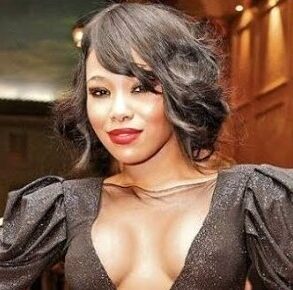This November (or Noirvember as it’s affectionately known to some), we at That Shelf have been celebrating our favourite film noir and neo-noir “baddies”: those women and men who lure, seduce, or otherwise entice characters (and us) to want what is sinful, corrupt, and forbidden. The women are known as femmes fatales while the men are identified by the lesser-known phrase, hommes fatales (which frankly doesn’t have the same kick). No matter what you call them, these characters are often misunderstood, misguided, and misanthropic in their intentions, narcissists to be sure, so for simplicity’s sake, let’s just call them wicked charmers.
Film noir is a world obsessed with those darkest corners of life, found in the grittiest city streets, bars, and motels. Much of it is shrouded by fog and shadows. These backdrops are conducive to hiding but are also places of release. The same can be said of noir’s personalities.
Many of these characters, whether intentionally or not, seek out those locales, the very ones that practically scream do not enter. Some people in noir are rotten to the core, while others just can’t help themselves, falling into traps so seductive that they can’t bear to do that one rotten thing that will damn them forever.
Noir provides an existential view of life, and whether innocent or fully aware, some characters thrive in this world while others perish. Many baddies write their own ticket like they’re asking for it, pushing the boundaries of decency too far. Others are good people teetering on a brink who simply make a bad decision, often in a split second, and always because that alluring promise of something better tempted them.
Classic noir of 1940s and 1950s America may have represented the gloomier side of Hollywood glamour, but it often had a lustrous pull of its own. The films possessed an intoxicating low-key, black-and-white visual style that has roots in German Expressionist cinematography. Noir’s tropes and conventions were formed during this time, including many now familiar characterizations. These films featured stars like Bogie and Bacall, Cary Grant, and Robert Mitchum – some of the era’s most beautiful and handsome people – each of whom made you want to give up everything for even the promise of a kiss.
Film noir didn’t have a name until critics looked back to that period some decades later. They noticed that the stylings and tendencies from those films were showing up again, though often in a manner less pronounced. From about the 1960’s until now, noir is a recognizable genre and film artists from around the globe use its characteristics as a basis for their films or use elements to interweave throughout. Film noir has enriched cinema history to the point that neo noir is now a malleable style. The characters from the classics are often serving as inspirations that can be developed further, in more exciting ways, now in a more modern, less restricted era.
Currently A lister directors and their Indie counterparts are able to dive into the original formulas fully or to dabble and play. Most recent directors include David Fincher, Christopher Nolan, John Dahl, Ridley Scott, David Lynch, the Coen Brothers, and genre blenders Park Chan-wook and Bong Joon ho, to name but a few. From just our examples alone, the range extends from an erotic thriller that works as a modern update of the classic form to a dystopian sci-fi action film to a combination animated, live action fantasy thriller comedy.
It’s great to see how artists now are using a genre that so clearly wanted to push boundaries so that they can push all boundaries themselves. Everything’s up for grabs now – and it’s also fun to look back on those classics to an era long gone, but never forgotten. And beware, there are spoilers ahead! – Emma Badame, Barbara Goslawski, Rachel West
Emma Badame:
Laura (Otto Preminger, 1944) – Waldo Lydecker (Clifton Webb)
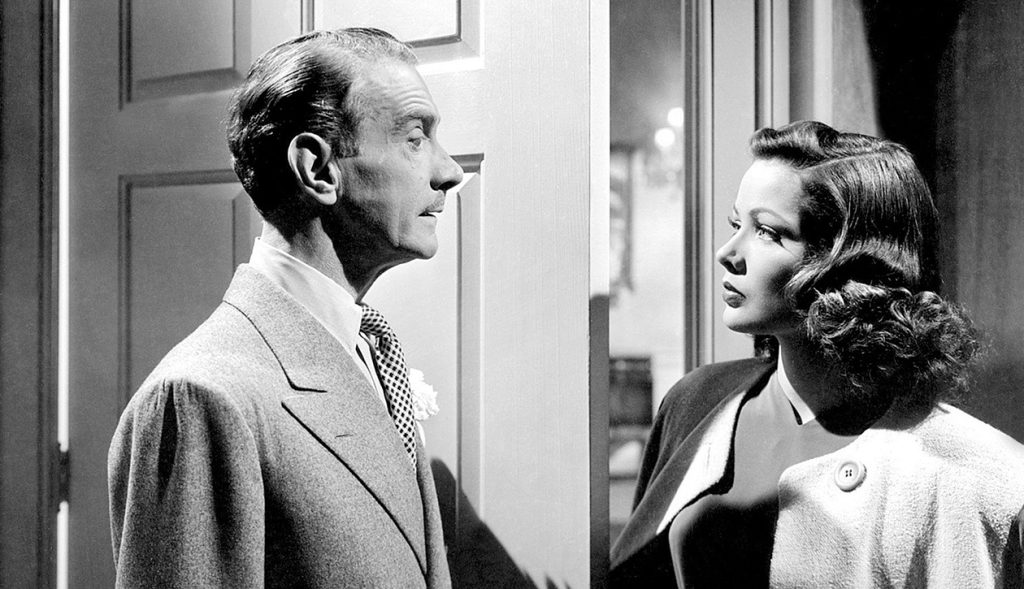
Memorably witty and captivatingly catty, Waldo Lydecker is one of the most delicious characters Hollywood has ever produced—and not just in a film noir context. But there’s far more to the character than his stylish, well-crafted exterior would have you believe. Actor Clifton Webb relishes every moment of his screen time, delivering each and every line like a expert marksman, cutting each and every other character to the quick given the opportunity—but he also manages to provide glimpses of the troubled man beneath the sarcastic facade. Given the character is a popular newspaper columnist and radio host character, it’s no surprise that Lydecker is eminently quotable, with a solid quip for every occasion. His dark, dangerous side creeps up on you slowly—much like it does to Gene Tierney’s titular character. Throughout the film, the writer styles himself as her Svengali, but when the young, very accomplished Laura outgrows his guidance (and interference in every aspect of her life), his carefully assembled life begins to crumble around him. It’s not the first cinematic tale of twisted obsession, but it is one of the most captivating due to Webb’s note-perfect, riveting portrayal. Kudos too must be given to the Jay Dratler, Samuel Hoffenstein, Betty Reinhardt, and Ring Lardner Jr.-penned script, an adaptation of Vera Caspary’s novel. Depressingly, the idea that men like Lydecker continue to feel entitled to women’s time, love and loyalty and often respond with violence when denied what they feel is their due makes the sinister story at the heart of Laura, and Waldo himself, just as relevant now as they were in 1944.
Colin Biggs:
The Third Man (Carol Reed, 1949) – Harry Lime (Orson Welles)
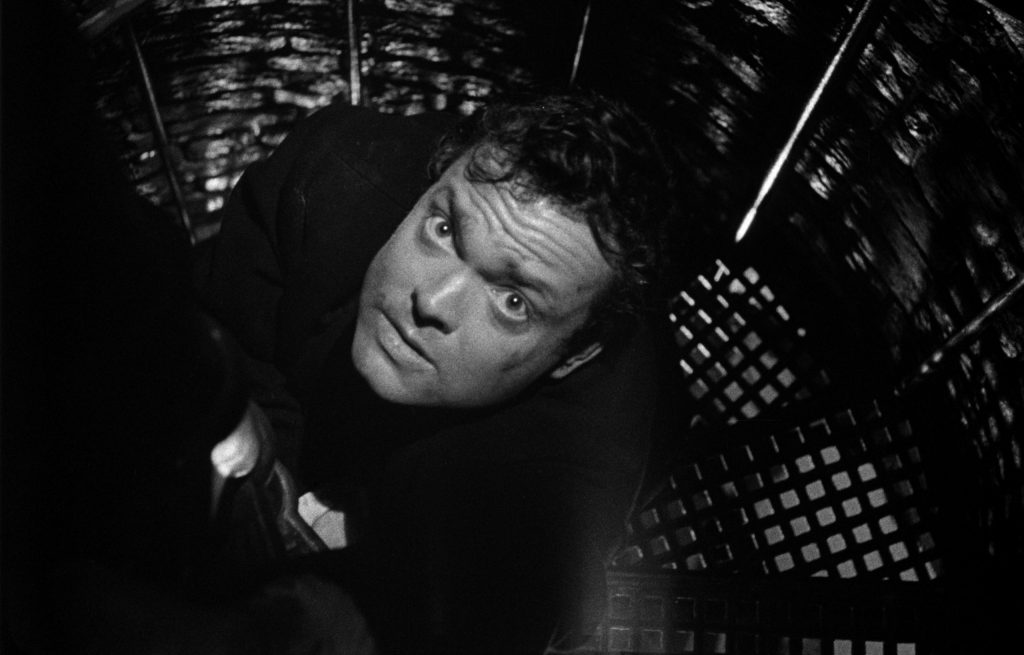
Harry Lime (Orson Welles) is the definition of a scene-stealer. No, he’s not the protagonist of The Third Man, and he only registers about five minutes of screentime, but he’s instantly the first image conjured when you think about the film. You hear about Harry Lime throughout the film. As the fondly remembered friend of Holly Martins (Joseph Cotten), we picture a courageous man. A man of substance lionized by war. After interviewing two English officers, they tell Martins a different side of his lifelong friend. A cur who stole penicillin from military hospitals and diluted it to sell on the black market. He abandoned empathy for the promise of a quick fortune. Oddly, this loathsome behavior doesn’t make the audience want to see Harry Lime any less. That’s all due to Welles’ performance. The stylistic reveal adds to the power of his introduction, yet only Welles could adequately convey the charismatic side of someone who gets away with murder. Using the scale and distance of the Ferris wheel to make streetwalkers appear small, Lime urges Holly, “Do you mean to tell me that if somebody came to you and said you could make a lot of money, but the only catch is that every once in a while, one of those dots might stop moving, you’d really say no?” Welles uses Lime as a reminder that evil can—and often is—charming.
Jason Gorber:
Blade Runner (Ridley Scott, 1982) – Rachael (Sean Young)
It sometimes takes an alternate perspective to fully shine the light on genre tropes, with Ridley Scott’s beloved 1981 film seemingly a perfect mode by which to interrogate (Voight-Kampff style) the very ingredients that set noir apart as a unique storytelling device. By any overt metric Rachael (Sean Young) fulfils the role of femme fatale brilliantly, a perfect foil for detective Deckard as she becomes both suspect and seductress. Her lethality lays less in duplicity that often connotes the character’s usage in the idiom, but in the way she quite literally destroys every foundational truth in Deckard’s world, upending things in ways both emotional and existential, leaving him questioning at the deepest level his own humanity.
If every hardboiled character needs a foil to drive the narrative forward, there’s no better exemplar that Rachael who manages to be simultaneously the object of interest and, ironically, the gateway to the detective’s own sense of humanity. Sean Young is splendid, allowing Ford’s brittleness to soften just enough for him to be vulnerable not only to her affections, but to truly understanding his own place in this crowded, neon-lit world, an alt-future Los Angeles where moments may melt away like tears in the rain, yet we see that love can transcend even the most ontological of differences.
Barbara Goslawski:
Double Indemnity (Billy Wilder, 1944) – Phyllis Dietrichson (Barbara Stanwyck)
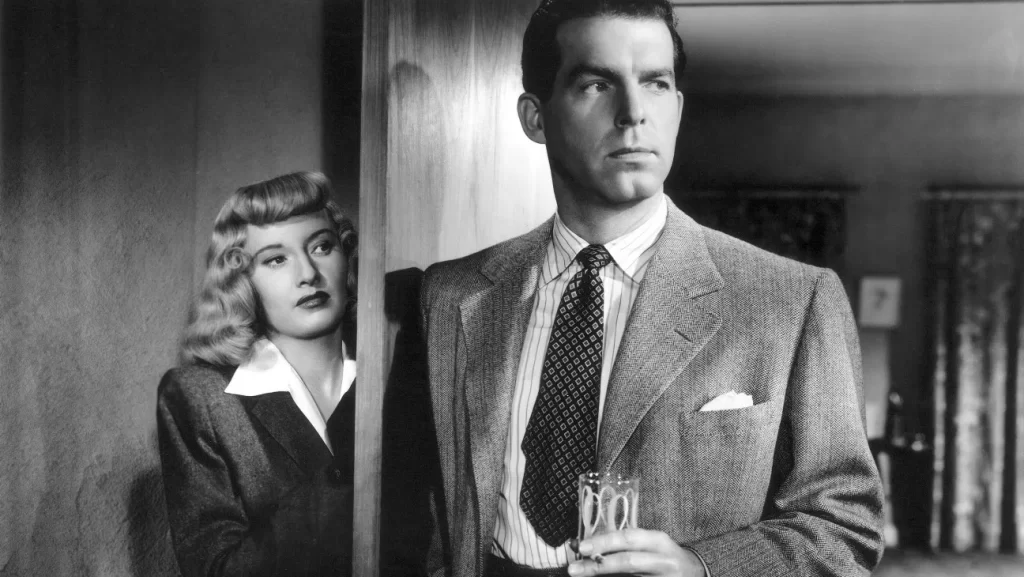
Barbara Stanwyck set the standard for femmes fatales in this noir classic. Cool and detached, she manipulates with effortless sex appeal. Phyllis Dietrichson is disenchanted, and dangerously bored, longing for freedom from her hard hearted, rich businessman husband. Seemingly on a whim, she hatches a murderous scheme with the hapless but horny insurance salesman, Walter Neff (Fred MacMurray), who’s thrilled by the chase, any chase, be it a deal or a dame. As soon as he sees Phyllis’ long lanky leg with that glimmering anklet, he is entangled in her snare. He is understandably obsessed.
Wilder’s script adaptation of James M. Cain’s 1943 novel of the same title, with author Raymond Chandler (The Big Sleep) is superbly sordid. It lays the perfect groundwork for that hypnotic atmosphere that Wilder conjures to make one consider the impossible. In Double Indemnity Wilder and Stanwyck create an erotically charged world in which one believes Phyllis can get away with murder, simply because she is so mesmerizing and intoxicating. Her icy charm is made all the more maddening by the fact that she so easily dissolves into tears, and for a moment her vulnerability is real. She is all the more desirable, and one wants to trust her as much as Walter Neff does. But even in film noir, Hollywood codes would not allow it and the cynical world that Wilder has crafted can only dangle that twisted hope before our eyes.
Pat Mullen:
Notorious (Alfred Hitchcock, 1946) – Alexander Sebastian (Claude Rains)
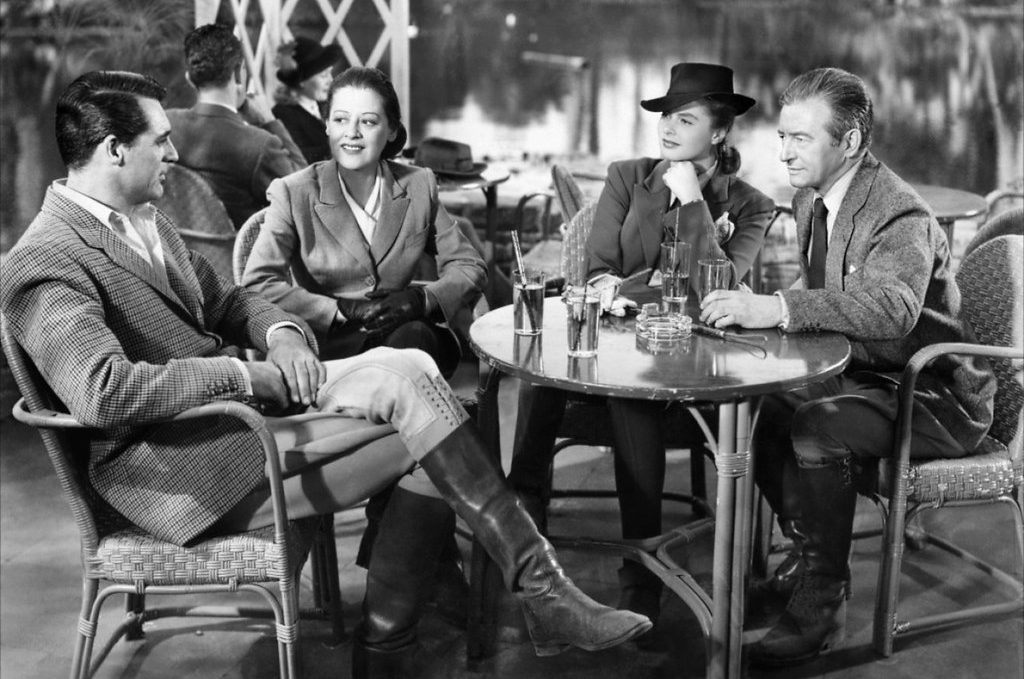
Is Alexander Sebastian a Nazi, a cuckold, or both? Casablanca fans might be thrown for a loop to see Claude Rains play the baddie in Alfred Hitchcock’s stylish thriller Notorious. Sebastian is a suave gentleman who masks his sinister side behind an elegant lifestyle and jovial charm. He is the target of an American espionage racket in which debonair spy T. R. Devlin (Cary Grant) recruits Alicia Huberman (Ingrid Bergman), the daughter of a convicted Nazi, to infiltrate an alleged Nazi haven in Brazil. Duty calls upon Alicia to cozy up with Alexander, whom she knew in her past life. They’re married even quicker than Maxim and the second Mrs. de Winter tie the knot in Rebecca, but Alicia finds herself in an equally sticky situation with an equally shady beau. Not only does it seem that Alexander harbours secrets for some obscure organization in his wine cellar, he’s also the insanely jealous type—but who wouldn’t be when Cary Grant’s lurking around? Rains doesn’t play the man in conventional noir fashion, though. He’s an enigmatic figure, likable even, as he wises up to Alicia’s spy game but realises that to expose her would be to reveal himself. Notorious ranks among Hitchcock’s most stylish affairs with venetian blinds, grand houses, exotic locals, and a seemingly endless flow of booze perfectly capturing the moral ambiguity of post-war life. Enjoy it with good wine.
Courtney Small:
The Last Seduction (John Dahl, 1994) – Bridget Gregory (Linda Fiorentino)
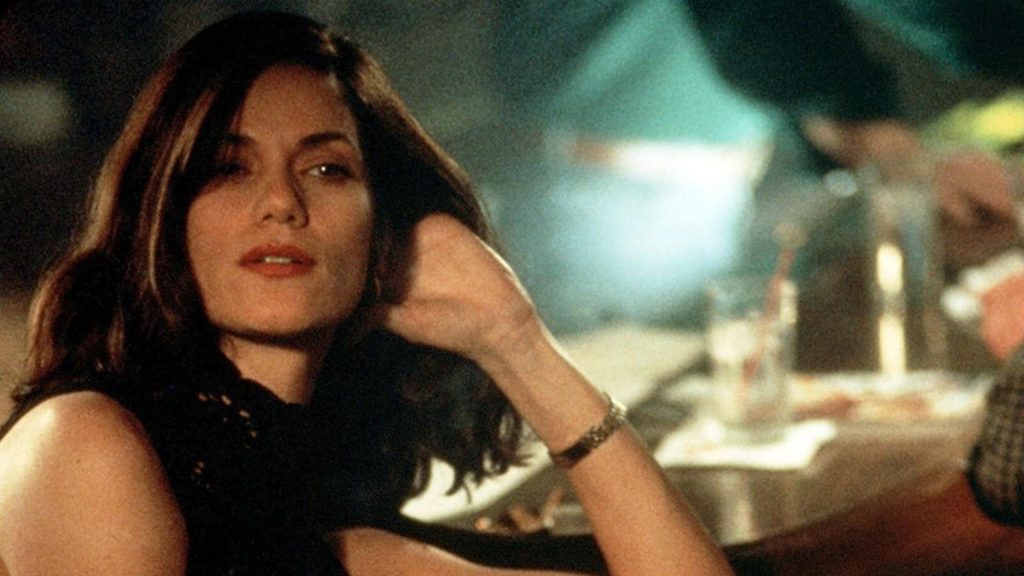
Cinema has provided many memorable femme fatales over the years, but few have been as iconic as Bridget Gregory in The Last Seduction. Played by Linda Fiorentino with an intoxicating mixture of sexy swagger, confidence, and a damsel in distress vulnerability, which can be turned on in the blink of an eye, Gregory is the ultimate chameleon. Always calculating, she adapts demeanor to suit each person she encounters. She can be both the domineering telemarketing manager and the coy wife who convinces her husband Clay (Bill Pullman) to illegally sell medical cocaine to drug dealers…only for her to steal the money for herself. This makes her the perfect foil for the men she manipulates in the film, most notably insurance salesmen Mike (Peter Berg) who she treats like her personal sex toy.
Part of the joy of experiencing John Dahl’s neo-noir is observing how Gregory uses her prowess to get herself out of the corners her actions and lies back her into. She can pivot from alluring siren to calculating ego stroker on the drop of dime, often turning the tables on those who foolishly believe they could ever have the upper hand on her. Always thinking five steps ahead of everyone else, Gregory is a formidable predator in a world where everyone is her unsuspecting prey.
Rachel West:
Who Framed Roger Rabbit (Robert Zemeckis, 1988) – Jessica Rabbit (Jessica Rabbit)
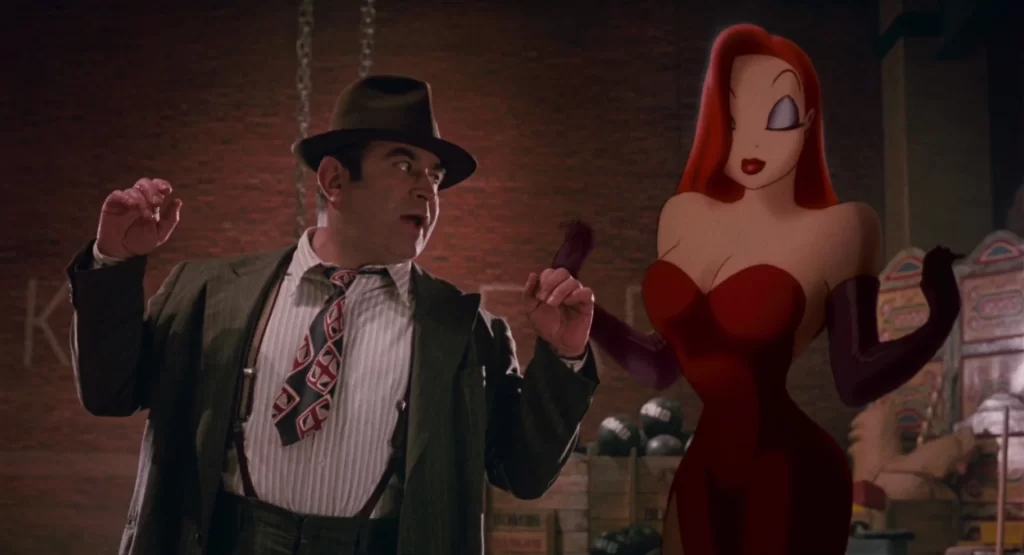
A femme fatale is known to lure her man into trouble, and that’s certainly the case of Who Framed Roger Rabbit’s sultry toon, Jessica Rabbit. She uses her provocative and mysterious feminine ways as a nightclub performer to seduce her male audiences. Like a true femme fatale, a hint of her love can drive a man to drastic actions. She’s the fantasy femme fatale with her red hair cascading over her eye reminiscent of Lauren Bacall with a deep voice to match, courtesy of Kathleen Turner.
Though she’s manipulative and overtly sexual, Jessica Rabbit bucks with femme fatale conventions through her private home life where she is a devoted and loving housewife. Deeply in love with her hubby, Roger Rabbit, she’s loyal to him but the thought she might not drive him to his wits ends. An exaggerated tongue-in-cheek stereotype of the femme fatale, Jessica Rabbit has come to represent the very idea she’s satirizing for modern audiences where her figure is used for comic relief in the film as much as it’s used as a weapon. After all, she’s not bad, she’s just drawn that way.
Who’s your favourite noir character?
Catch up on our look at our favourite Noir Double Bills!
Advertisement
Advertisement
FROM AROUND THE WEB
Advertisement
This post was originally published on this site be sure to check out more of their content.






